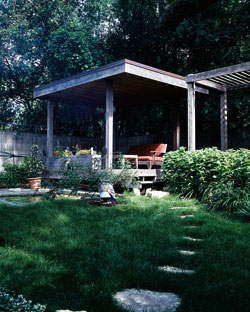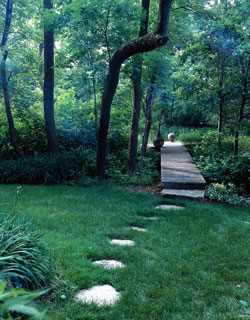 |
|
The raised and roofed pavilion is 20 yards from the house but feels like a remote destination. Setting it atop steel girders suggests that the low, wet part of the yard is even lower than it actually is. ::: view gallery
|
 |
|
The twists, angles, and changes of materials in the path from the raised patio back to the house conceal the fact that you could actually walk from one to the other in a straight shot. “The paths slow you down so you can |
Their Glenview backyard was low and often full of water, but Gary Alan and Susan Fine didn’t let that dampen their gardening ambitions. Instead, they decided to rise above it.
With advice from landscape architects Peter Lindsay Schaudt and Chandra Goldsmith, the Fines developed an innovative yard whose defining feature is the two long footbridges—one of rusticated wood, the other of sleek aluminum—that span the marshy ground.
Visually appealing in their own right, the bridges also enhance the pleasure of wandering around this normal-sized suburban lot. You don’t merely walk past garden plants; you walk above them, enjoying the overview (as well as the sight of little stalks poking up through the grid work). And the pergola-covered oasis at the back corner of the lot feels like an exotic destination, not just a seating area, after you cross a 25-foot bridge to get to it.
The wooden bridge unifies the garden, says Schaudt, visually connecting the house with the wooden pavilion and knitting together the trees and the bamboo fence—an effect that’s traditional in Japanese gardens. The metal bridge about 30 feet east of it interprets a traditional idea in a more contemporary way. “In a Japanese garden, you’ll see a footbridge that takes a sharp turn to confuse evil spirits that might try to cross the bridge,” he says, “but you wouldn’t see it in a sleek new metal.”
The garden is filled with a remarkable array of plants that Susan has become smitten with. But if it weren’t for the built pieces—the bridges; a dramatic, stair-stepping bamboo fence; two charming copper gates with sculpted cattails; a round terrace in the front yard—the plants might all dissolve into an undifferentiated visual mass. The fabricated parts give the garden structure, and lots of it.
The project started as an attempt to clean up a messy backyard. “The neighborhood drained into our yard—there were times when we couldn’t walk out there because the water was up past our ankles,” says Susan. The Fines turned to Schaudt and his then-associate Goldsmith, who together dreamed up the knee-high bridges. Rather than do major grading to make it a typical flat backyard, they “decided to embrace the uniqueness of the lot and make the most of what a water garden can be,” Goldsmith says.
When Schaudt and Goldsmith suggested going with what wanted to be there, the Fines dived in happily. Susan, who had hardly dabbled with bog plants before, has become a wetland plant aficionado. Even though Glenview has upgraded the storm sewer system so the yard gets less of the neighborhood’s runoff, the Fines love their bridges, and are keeping them.
“You’re walking on a narrow bridge and it changes direction. If you don’t pay attention, you’ll fall off,” Gary says. “The bridges create a need for mindfulness. You don’t get that just walking around in a backyard.”
Photography: Nathan Kirkman



